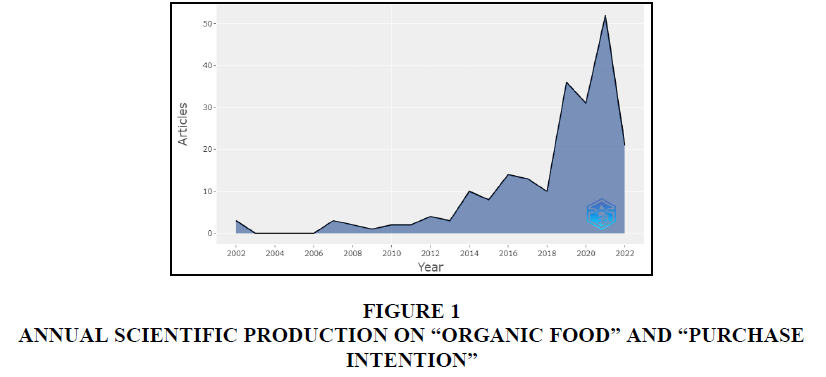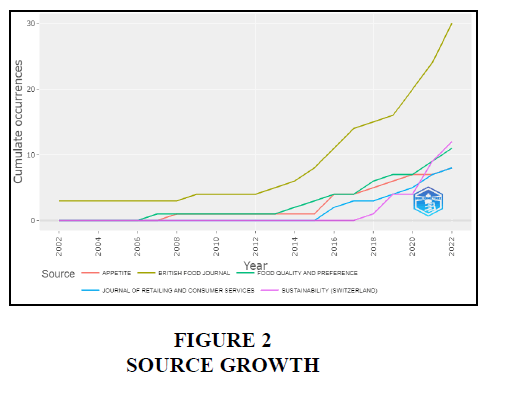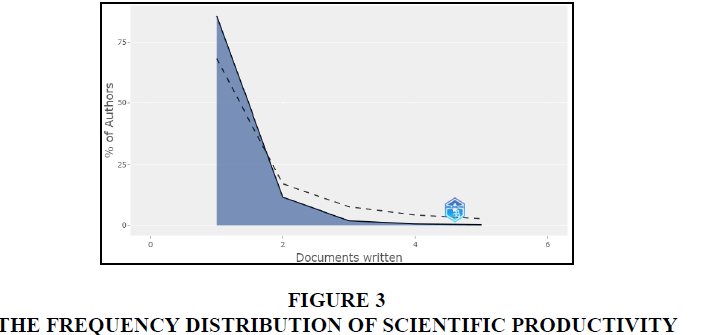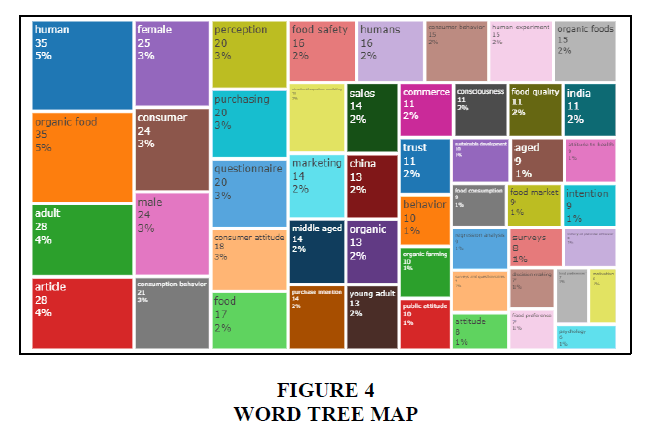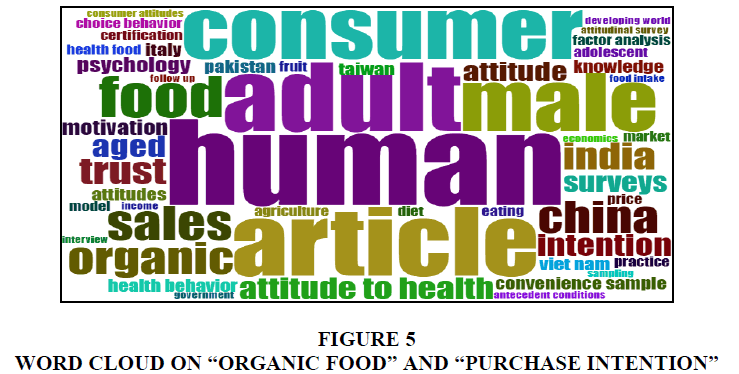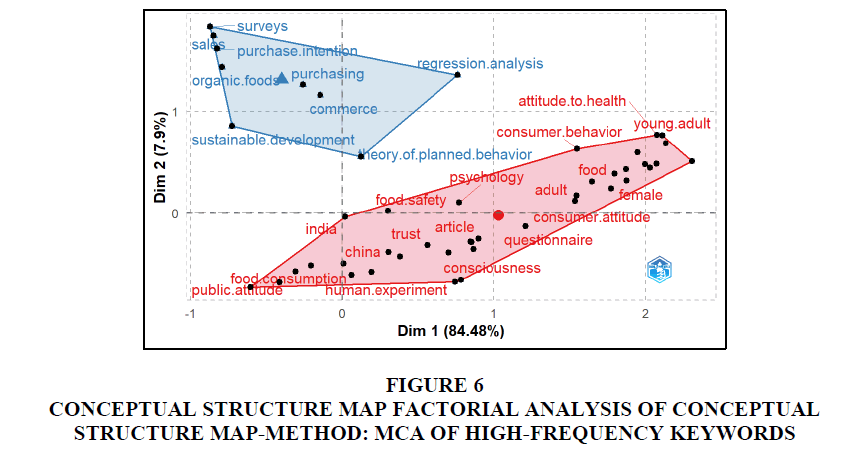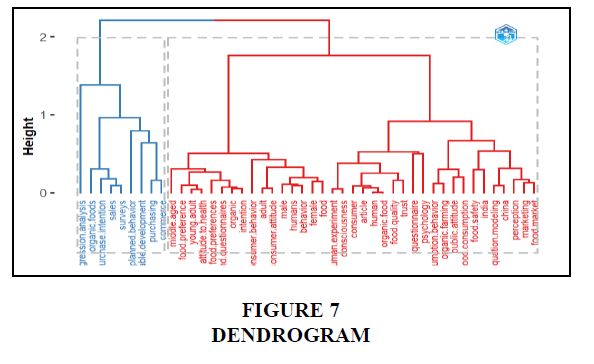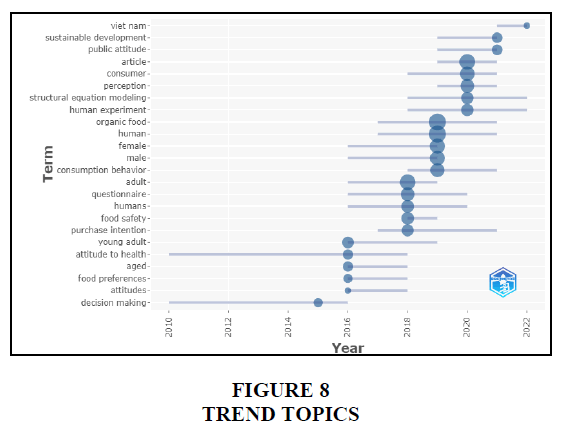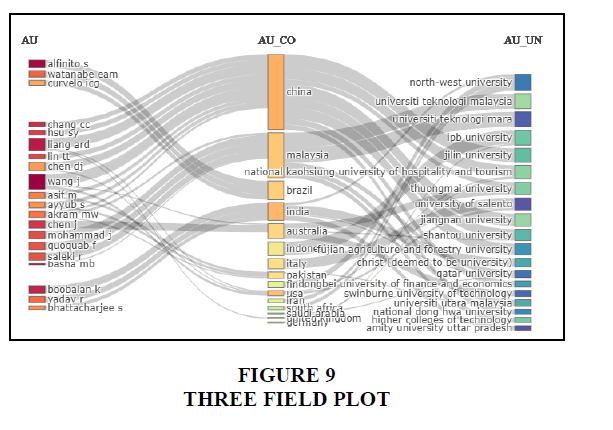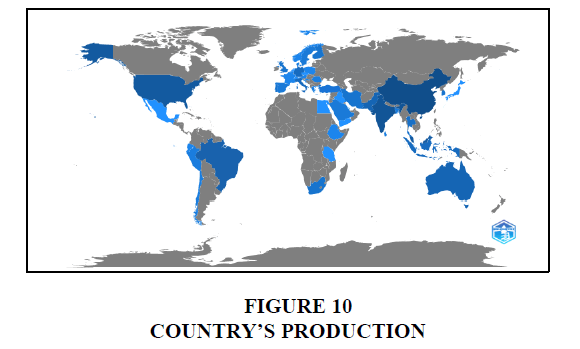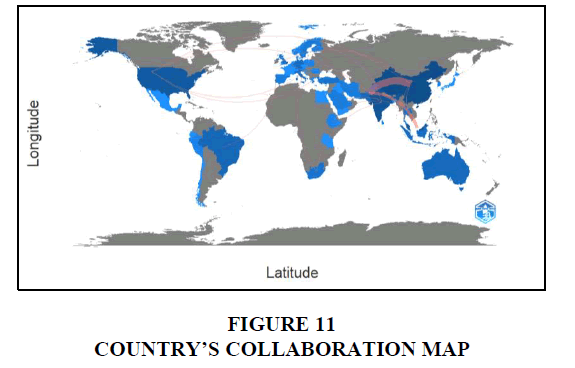Research Article: 2022 Vol: 26 Issue: 6
Is Organic Food Leading to Its Purchase Organically? Insights from Bibliometric Analysis
Arpan Anand, Jaipuria Institute of Management, Noida
Sakshi, Fortune Institute of International Business, New Delhi
Sapna Jangra, Maharshi Dayanand University, Rohtak
Anjali Gupta, Maharshi Dayanand University, Rohtak
Kumar Aashish, Jaipuria Institute of Management, Noida
Citation Information: Anand, A., Sakshi, Jangra, S., Gupta, A., & Aashish, K. (2022). Is organic food leading to its purchase organically? insights from bibliometric analysis. Academy of Marketing Studies Journal, 26(6), 1-18.
Abstract
The theme of organic food has evolved gradually. Recent developments in the field of organic food heightened the need for analysing how this theme has evolved, what academic efforts have been made to advance and develop this field, who are the major contributing authors and much more. The aim of this paper is to apply bibliometric analysis tools to evaluate the studies conducted on “Organic food” and “Purchase intention”. Diverse characteristics have been discussed by researchers in previous studies to explain why consumers purchase and consume organic food. A Review of research papers published on “Organic food” and “Purchase intention” within the timeframe from the year 2002 to 2022. The bibliometric analysis revealed the top contributing authors, journals, citation analysis, country’s scientific production and trending topics. The results of the study revealed top five contributing authors having most publications and most active journals that published on “Organic food” and “Purchase intention” includes British food journal with highest publications followed by sustainability, food quality, consumer studies and marketing. Further, largest number of articles were published in China with 85 studies followed by India, USA, Malaysia and Brazil. It can be seen that the higher number of studies are conducted in developing countries in comparison to developed one.
Keywords
Purchase Intention; Bibliometric Study; Organic Food.
Introduction
The concern for negative effect of environmental degradation on health of human beings is the major area, which is being focussed by researchers presently Tewary et al. (2021); Yadav & Pathak (2016). Industrialization emanates from overconsumption. Consumers are becoming aware of the consequences on their health and environment due to the activities of industries Qasim et al. (2019). As a result, their eating habits have changed. They are becoming more conscious about their health. Due to this increasing concern, organic food consumption is increasing. Production of organic food focusses on low greenhouse gas effect, conservation of natural resources and aims at reduced pollution Asif et al. (2018). Willer & Lernoud (2017) reports nearly 10% increase in organic agro products sale in 2018 when compared to 2017 in US market. This result was further supported by Paul & Rana (2012) by presenting demand from consumer side as the driver of this increased sales. Demand for organic food is rapidly increasing in all markets including India. Sikkim, an Indian state is actively engaged in promoting production of organic food (1). Indian government is also providing support by curbing restrictions and lowering the sales tax on export of organic food. As a result, India exports to developed countries such as U.S.A and Europe Sekhar et al. (2021); Kushwah et al. (2019). Purchase intention reflects attitude of consumers to purchase and their willingness to pay for it. In simple terms, it is a signal of purchase behaviour Howard & Sheth (1969). Large number of studies on purchase intention of organic food are conducted by scholars and researchers in western countries. For instance, individual cognition and trust, health concerns and awareness, environmental concerns, food safety and quality, moral attitude, price and lifestyle are the individual indicators which affects the purchase intentions of organic food consumers Asif et al. (2018); Lauretti & Benedetti, 2018; Janssen (2018); Singh & Verma (2017); Du et al., 2017; Brya, 2016; Ueasangkomsate & Santieerakul (2016); Lee & Yun (2015); Basha et al. (2015); Cho & Krasser (2011). In addition to this, Szolnoki & Hauck (2020) discussed some geographical factors which affects the organic food purchase intention.
The theme of organic food has evolved gradually. Recent developments in the field of organic food heightened the need for analysing how this theme has evolved, what academic efforts have been made to advance and develop this field, who are the major contributing authors and much more. So, this study will focus on addressing the contributing researchers as well as overall momentum of the publications. Recent developments highlight the numerous aspects of organic food purchase intention. Diverse characteristics have been discussed by researchers in previous studies to explain why consumers purchase and consume organic food. For instance, lower effect on environment, health benefits, food safety and quality, its nutritional value, availability, taste and premium price have been discussed in previous researchers. Theory of planned behaviour is widely theory by most of the studies as underlying theory. In spite of availability of comprehensive review available on current topic, lack of evidence available on evolution, trends and themes in this topic. As per authors’ knowledge, no previous study exists on this topic which have used Biblioshiny by R Package in order to get the deeper understanding of the field organic food and purchase intention and country wise scientific production or Sankey’s diagram to explain a deeper viewpoint of this topic. So, the current study aims at assessing the overall impact and productivity of available studies in the literature.
The main contribution of this paper lies in the fact that findings from 215 articles published on organic food and purchase intention are discussed by using bibliometrics which is extending its reach in different disciplines. Bibliometric analysis is a powerful tool used to quantitatively investigate the findings available in the literature of various disciplines in order to reveal recent trends and thematic evolution (Ahmi & Mohammad, 2019). Bibliographical information needs to be collected to conduct bibliometric analysis. Bibliographical information includes information related to author, affiliations, year, country, publisher, keywords, citations count, document type etc. This complete information is readily available on academic databases i.e., Scopus, Web of Science, CrossRef, PubMed etc. It is a five-step process. Authors used R Package “Bibliometrix” to conduct the analysis. Biblioshiny is a software which provide interface for conducting bibliometric analysis. Research question framed for the current study are:
Q1: What are the global trends in scientific production in the area of “Organic food” and “Purchase intention”?
Q2: What information is not considered or explored yet in this trend?
Q3: In what area future research can be conducted or developed?
The main objectives of this bibliometric analysis are:
1. To Provide bibliometric information on 215 articles extracted from Scopus database; 2. To use Biblioshiny software in R package to obtain scientific information on articles in the database; 3. To understand the leading authors, leading countries and leading journals through citation analysis, country scientific production and several other techniques.
This article is structured as follows.
Methodological aspect is defined in section
2. Technical phases are presented in section
3. Results containing main bibliometric information are presented in section
4. The last section discussed about discussion and research implications for future.
Methodology
Largest abstract indexing, the Scopus database that would help in collecting all the relevant studies for a particular topic, is used for data collection purpose. This database provides an advanced search options so as to enable researchers to collect accurate results, mainly, in broad areas. Keywords used for extraction of data includes “Organic food” and “Purchase intention” within the timeframe of 20 years from 2002 to 2022.
Technical Phases in Bibliometric Study
Zupic & Cater (2015) recommended five stages of a standard workflow for science mapping:
1. Study Design – Three research question are framed initially. These research questions were transformed into objectives later. The most important keywords in Scopus database found were “Organic food” and “Purchase intention”. Criteria used for choosing keywords was to look in for high level publication keywords. Chen & Xiao (2016) highlighted the two methods for choosing keywords. First one, high level publication keywords can be used for searching keywords. The other one is to select the keywords that represent relatively a large field of study. The time span chosen for the study is 20 years from 2002 to 2022.
2. Data collection – Second stage consist of selecting the database that contains bibliometric information. This study extracted data from Scopus database in “bib” file format. This format is accepted by Biblioshiny software in R Package.
3. Data analysis – Bibliometrix codes were used in R Package to produce results in descriptive form. Biblioshiny, a web-based interface of Bibliometrix, is used to construct different charts, networks and conceptual maps.
4. Data visualization – After the analysis of results, data reduction technique is applied for visualization purpose.
5. Data Interpretation – Finally, on the data analysis and interpretation stage, main bibliometric information is described and then the results were analyzed. Top authors, journals, keywords and countries are considered. Each one of these is thoroughly analyzed providing the following details: i) Main bibliometric information; ii) Annual scientific production; iii) Important sources; iv) Author’s scientific productivity using the Lotka’s law; v) Author’s keywords (using tree map and word cloud); vi) Conceptual structure through MCA method; vii) Dendrogram; viii) Trending topics; ix) Citation of top articles; x) Country’s production; xi) Country’s citations; xii) Collaboration map of the country.
Results
Descriptive Bibliometric Analysis
Table 1 represents the main information on the data collected from Scopus database of 215 publications within the time span of 20 years from 2002 to 2022. These articles were from 113 sources including journals and book chapters. Keywords plus are the words or phrases that appears frequently in titles of the articles. Keywords plus is more than double the number of articles here. It helps in investigating the knowledge structure of organic food and purchase intention. So, it is as effective as the author keywords. Average citations received by one document is 34.36. Total of 215 publication documents include 197 articles, 10 conference papers, 4 review papers and 1 book, book chapter, conference review and note each. Author keywords are those words or phrases which reflects the content of the document. Descriptive Analysis revealed that only 27 documents are single authored documents. Total number of authors who worked on organic food and purchase intention was 544. Co-authors per document are 2.98. It means each article is authored by two authors on an average of 2.98. Collaboration index is 2.76 which is calculated on the basis of authors from multi-authored articles. Total number of references in all the documents related to organic food and purchase intention are 13109. Figure 1 shows that research on Organic food and purchase intention has been increasing since 2009. However, it gained momentum from 2014 Table 1 and Figure 1.
| Table 1 Main Information |
|
|---|---|
| Description | Results |
| Timespan | 2002:2022 |
| Sources (Journals, Books, etc) | 113 |
| Documents | 215 |
| Average years from publication | 3.75 |
| Average citations per documents | 34.36 |
| Average citations per year per doc | 5.173 |
| References | 13109 |
| Keywords Plus (ID) | 453 |
| Author's Keywords (DE) | 539 |
| Authors | 544 |
| Author Appearances | 640 |
| Authors of single-authored documents | 26 |
| Authors of multi-authored documents | 518 |
| Single-authored documents | 27 |
| Documents per Author | 0.395 |
| Authors per Document | 2.53 |
| Co-Authors per Documents | 2.98 |
| Collaboration Index | 2.76 |
215 articles were considered in this bibliometric analysis. Top journal is British food journal which have published maximum number of articles on “Organic food” and “Purchase intention”. Other journals that included topics about organic food and purchase intention are listed in table 2. Table 2 presents top 20 sources Table 2.
Figure 2 presents visual representation of top 5 journals that dealt with exceptionally publish the related topics. It can be seen that tremendous increase in published articles on the said topic from 2015 to 2022 Figure 2.
| Table 2 Sources That Involve “Organic Food” And “Purchase Intention” |
|
|---|---|
| Sources | Articles |
| british food journal | 30 |
| sustainability (switzerland) | 12 |
| food quality and preference | 11 |
| appetite | 8 |
| journal of retailing and consumer services | 8 |
| international journal of environmental research and public health | 6 |
| journal of cleaner production | 5 |
| foods | 4 |
| frontiers in psychology | 4 |
| international journal of consumer studies | 4 |
| journal of food products marketing | 3 |
| journal of international food and agribusiness marketing | 3 |
| management of environmental quality: an international journal | 3 |
| sage open | 3 |
| acm international conference proceeding series | 2 |
| indian journal of ecology | 2 |
| international journal of applied business and economic research | 2 |
| international journal of innovative technology and exploring engineering | 2 |
| journal of agribusiness in developing and emerging economies | 2 |
| journal of business research | 2 |
Authors
This section deals with top most authors in “organic food” and “purchase intention” who are most frequently cited. Top 10 authors are listed in Table 3 below. Wang has highest publications (5) and ranked as most prolific author, followed by Alfinito and Basha with 4 and Liang, Boobalan, Chang, Chen, Hsu, Lin and Mohammad each with 3 publications. The research work publications productivity of top 10 authors varied from 3 to 5 Table 3.
| Table 3 Productivity Of Authors |
|
|---|---|
| Authors | Number of Articles |
| Wang j | 5 |
| Alfinito s | 4 |
| Basha mb | 4 |
| Liang ard | 4 |
| Boobalan k | 3 |
| Chang cc | 3 |
| Chen j | 3 |
| Hsu sy | 3 |
| Lin tt | 3 |
| Mohammad j | 3 |
Lotka’s Law presents the relation between authors and their scientific production. It is an asymmetric distribution which shows concentration of articles written by a few authors only. Figure 3 revealed that more than 75% of authors have written at least 3 articles. Figure 3 revealed the graphical distribution of documents written Figure 3.
Author Keywords
This section contains information on keywords found in the articles between “Organic food” and “Purchase intention”. It was found that several keywords were included by researchers in their articles. Table 4 displays top 20 keywords which are most frequently used by the authors in their articles. The following words are not predictive. However, these keywords highlight the key features or variables of organic food and purchase intention studies. For example, consumer attitude, gender, perception, food safety affects the consumer’s intention to purchase and their actual purchasing of organic food or organic food related purchase behaviour. And the Structural equation modeling keyword may reveal that this is most widely used method in these studies Table 4.
| Table 4 Authors’ Keywords In “Organic Food” And “Purchase Intention” |
|
|---|---|
| Words | Occurrences |
| Human | 35 |
| organic food | 35 |
| Adult | 28 |
| Article | 28 |
| Female | 25 |
| Consumer | 24 |
| Male | 24 |
| consumption behavior | 21 |
| Perception | 20 |
| Purchasing | 20 |
| questionnaire | 20 |
| consumer attitude | 18 |
| Food | 17 |
| food safety | 16 |
| Humans | 16 |
| consumer behavior | 15 |
| human experiment | 15 |
| organic foods | 15 |
| structural equation modeling | 15 |
| Marketing | 14 |
A tree map presents data in form of nested rectangles. Area of each rectangle is proportional to its value. Figure 4 provides a tree map of combination of words. It is slightly different from above table. It displays the overall percentage along with frequency of keywords used. More relevant insights can be drawn from the tree map. For example, it can be seen that small number of studies have been conducted in organic farming as compared to organic food. Or it can be said that most of the studies used adult consumer as their sampling unit. In addition, Figure 5 shows the word cloud to indicate the magnitude in order to present a more precise information on the keywords used by authors Figure 4 - 5.
Multiple Corrrespondence Analysis of High-Frequency Keywords
Multiple Correspondence Analysis (MCA) was conducted of keywords included in the dataset. Results of MCA are presented in Figure 6. Xie et al. (2020) reported that the keywords near the central point are being highly investigated research areas in current years by the authors. Relative positions of the points along the Dim 1 and Dim 2 are used to create mapping between words. Similar words that are related to each other or having similar values are close to each other. Higher the similarity between words, more they will be closed to each other (Aria & Cuccurullo, 2017). Conceptual structure in Figure 6 represents 2 clusters. Blue colour cluster consist of 9 words including purchase intention, organic food, sustainable development and theory of planned behaviour. Red colour cluster consist of 18 words related to consumer attitude and behavior, psychology, trust, consciousness, attitude towards health and food consumption Figure 6 Du et al. (2017).
Figure 6:Conceptual Structure Map Factorial Analysis Of Conceptual Structure Map-Method: Mca Of High-Frequency Keywords.
A dendrogram displays the hierarchical relationship between objects. It is generally used for hierarchical clustering. Main aim of dendrogram is to allocate the objects into clusters. To interpret dendrogram, emphasis should be given on heights of link that join the objects Aidi Ahmi (2019).
The identified clusters were divided into two categories. The first one reveals the consequences of organic food. It also highlights the techniques used and the underlying theory. It can be seen that organic food, purchase intention, actual purchase and sales are closely related. Organic food affects the purchase intention and actual purchasing behavior of consumers which further helps in triggering sales of organic food products. The second one highlights the antecedents of organic food. It can further be sub divided into socio-demographic factors and psychology and perceptions of consumers. Socio-demographic factors consist of gender, age and Country can be used to analyse what impact they have on purchase intention of consumers. The second one is related to health concerns, food preference, food quality, trust in retailer or brand and food safety concerns Figure 7.
Figure 8 provide evidence on how the theme “Organic food” and “Purchase intention” evolved over time. From 2010 to 2016, “Organic food” and “Purchase intention” were mainly related to dominant themes such as decision making, consumers’ attitude and their food preferences, Age and Health concerns. Since 2016, purchase intention and food safety concerns were trending topics. An analysis from the year 2019 to present, major themes explored were consumer behaviour, organic food, perception and attitude of consumers and sustainable development. Lastly it can be said that research related to “Organic food” and “Purchase intention” has mainly been conducted in developing countries Figure 8 Hsu et al. (2016).
Citations
Table 5 depicts the top 20 articles that receive high number of citations. The article that is most cited is from Arvola et al. (2018) with 501, followed by Michaelidou & Hassan (2008), Chen (2007) and Paul & Rana (2012) with 458, 433 and 366 respectively. The most cited journal is Appetite followed by Journal of consumer studies, Food quality and preference and Journal of retailing and consumer services Table 5 Rana & Paul (2017).
| Table 5 Articles Receive Citations |
|||||
|---|---|---|---|---|---|
| Sr. No. | Title of the paper | Author | Journal | Total Citations | TC per Year |
| 1 | Predicting intentions to purchase organic food: The role of affective and moral attitudes in the Theory of Planned Behaviour | Arvola et al. (2008) | Appetite | 501 | 33.4 |
| 2 | The push and pull towards organic: clarifying the roles of health consciousness, food safety concern and ethical identity. | Michaelidou & Hassan (2008) | Journal of Consumer Studies | 458 | 30.533 |
| 3 | Attitudes and purchase intentions in relation to organic foods in Taiwan: moderating effects of food-related personality traits | Chen (2007) | Food quality and preference | 433 | 27.062 |
| 4 | Consumer behavior and purchase intention for organic food: A review and research agenda | Paul & Rana (2012) | Journal of Retailing and Consumer Services | 366 | 61 |
| 5 | Consumers’ perceptions of organic food attributes and cognitive and affective attitudes as determinants of their purchase intentions toward organic food | Lee & Yun (2015) | Food quality and preference | 283 | 35.375 |
| 6 | Consumer behavior and purchase intention for organic food | Paul & Rana, (2012) | Journal of Consumer Marketing | 256 | 23.273 |
| 7 | Intention to purchase organic food among young consumers: Evidences from a developing nation | Yadav & Pathak (2016) | Appetite | 255 | 36.429 |
| 8 | Eating clean and green? Investigating consumer motivations towards the purchase of organic food | Smith & Paladino (2010) | Australasian Marketing Journal | 228 | 17.538 |
| 9 | Consumers' purchase intention of organic food in China | Yin et al. (2010) | Science of Food and Agriculture | 181 | 13.923 |
| 10 | I Eat Organic for My Benefit and Yours”: Egoistic and Altruistic Considerations for Purchasing Organic Food and Their Implications for Advertising Strategists | Kareklas et al. (2014) | Journal of Advertising | 173 | 19.222 |
| 11 | Decisional factors driving organic food consumption: Generation of consumer purchase intentions | Teng & Wang (2015) | British Food Journal | 172 | 21.5 |
| 12 | Purchasing motives and profile of the Greek organic consumer: a countrywide survey | Fotopoulos & Krystallis (2002a) | British Food Journal | 160 | 7.619 |
| 13 | Factors influencing Indian consumers' actual buying behaviour towards organic food products | Singh & Verma (2017) | Journal of Cleaner Production | 153 | 25.5 |
| 14 | Determinants of Regular and Occasional Consumers' Intentions to Buy Organic Food | Pino et al. (2012) | The Journal of Consumer affairs | 145 | 13.182 |
| 15 | Determinant factors influencing organic food purchase intention and the moderating role of awareness: A comparative analysis | Asif et al. (2018) | Food quality and preference | 131 | 26.2 |
| 16 | Organic product avoidance: Reasons for rejection and potential buyers’ identification in a countrywide survey | Fotopoulos & Krystallis (2002b) |
British Food Journal | 126 | 6 |
| 17 | An analysis of purchase intentions toward organic food on health consciousness and food safety with/under structural equation modeling | Hsu, et al., 2016 | British Food Journal | 109 | 15.571 |
| 18 | The effects of organic labels on global, local, and private brands: More hype than substance? | Bauer et al. (2013) | Journal of Business Research | 108 | 10.8 |
| 19 | Importance of health and environment as quality traits in the buying decision of organic products | Mondelaers et al. (2009) | British Food Journal | 107 | 7.643 |
| 20 | Corporate social responsibility and the positioning of grocery brands: An exploratory study of retailer and manufacturer brands at point of purchase | Anselmsson & Johansson (2007) | International Journal of Retail & Distribution Management | 100 | 6.25 |
Three Field Plot Relations between top 20 Affiliations, Authors, and Countries
A multi-field plot between top 20 Affiliations, Authors, and Countries is displayed in Figure 9. Figure 9 depicts that top author working on “Organic food” and “Purchase intention” are from China, Malaysia, Brazil and India. North-west university is at the top having affiliations from India, South Africa, Iran and Finland Rana & Paul (2017). Other top university are from Malaysia, Indonesia and Germany. Most work related to “Organic food” and “Purchase intention” is conducted in China Rana & Paul (2017). Sankey’s diagram revealed that 9 authors are from China, 5 from Malaysia and 3 from each Brazil and India. China has affiliations from highest number of universities in various countries. Top most authors Alfinito, Watanabe and Curvelo are from Brazil Figure 9 Bryła (2016).
Country
This section deals with geographical distribution of articles on organic food and purchase intention. Countries whose articles were used for analysis purpose is shown in Table 6 and Figure 10. Largest number of articles were published in China with 85 studies followed by India, USA, Malaysia and Brazil. It can be seen that the higher number of studies are conducted in developing countries in comparison to developed one. It means that organic food consumption has significantly higher demand in developing countries when compared to developed. However, demand has started accelerating in developed countries. The countries ranked below are Sweden, Spain, Saudi Arabia, Bangladesh and Turkey. Figure 10 depicts the country’s scientific production. Countries having dark blue colour indicates high productivity, blue one signifies the different rates of productivity and grey colour signifies no production at all Table 6 and Figure 10.
| Table 6 Country Wise Distribution Of Articles |
|
|---|---|
| Region | Frequency |
| China | 85 |
| India | 53 |
| Usa | 37 |
| Malaysia | 33 |
| Brazil | 21 |
| Australia | 17 |
| Pakistan | 15 |
| Italy | 12 |
| Germany | 11 |
| Indonesia | 11 |
| Thailand | 8 |
| Uk | 7 |
| Finland | 6 |
| Iran | 6 |
| Portugal | 6 |
| South africa | 6 |
| South korea | 6 |
| Turkey | 5 |
| Bangladesh | 4 |
| Saudi arabia | 4 |
| Spain | 4 |
| Sweden | 4 |
Country Production and Citations
This section discussed about citations received by each country. Top 20 countries which receive high number of citations are depicted in Table 7. It also explains the document collaborations network and mapping among researchers on the organic food and purchase intention topic in other countries. As per table, China, USA and India plays leading roles. However, Finland, Australia, United Kingdom, Italy and Germany were also having high number of citations Laureti & Benedetti (2018). Figure 11 depicts the path of global cooperation. International research networks are indicated by blue colour. Countries having high level production collaborate with each other Table 7 and Figure 11.
| Table 7 Country Wise Citations |
||
|---|---|---|
| Country | Total Citations | Average Article Citations |
| China | 1674 | 40.83 |
| Usa | 972 | 88.36 |
| India | 660 | 33.00 |
| Finland | 553 | 276.50 |
| Australia | 492 | 70.29 |
| United kingdom | 458 | 458.00 |
| Italy | 228 | 57.00 |
| Germany | 163 | 27.17 |
| Sweden | 131 | 65.50 |
| Malaysia | 111 | 7.93 |
| Belgium | 107 | 107.00 |
| Spain | 93 | 46.50 |
| Korea | 90 | 30.00 |
| Brazil | 72 | 18.00 |
| Romania | 69 | 69.00 |
| Turkey | 62 | 15.50 |
| Austria | 60 | 30.00 |
| Saudi arabia | 47 | 23.50 |
| Pakistan | 36 | 18.00 |
| Qatar | 27 | 13.50 |
Discussion
The main aim of this study is to provide evidence on how does the theme of “Organic food” and “Purchase intention” evolved over a period of 20 years in terms of authors, journals, country and so on. The top five contributing authors having most publications are Arvola et al. (2008), Michaelidou & Hassan (2008), Chen (2007) and Paul & Rana (2012) and Lee & Yun (2015). Arvola et al. (2008) examined the significance of affective and moral attitudes in theory of planned behaviour in prediction of purchase intention of organic food. This study was conducted in three countries: Italy, UK and Finland to provide more generalizable results. Michaelidou & Hassan (2008) focussed on identifying role of health consciousness, concern for food safety and ethical self-identity in predicting consumers’ attitude and purchase intention towards organic food. Chen (2007) aims to investigate the driving forces of Taiwan consumers’ attitude towards organic food for providing support to Ajzen’s theory of planned behaviour. A review study conducted by Paul & Rana (2012) explored the factors affecting change in organic food consumers’ behavior. Study conducted by Lee & Yun (2015) applied S-O-R model to explain how utilitarian and hedonic attitudes affects purchase intention of organic food consumers.
Most active journals that published on “Organic food” and “Purchase intention” are British food journal with highest publications (30). The journals that explored and extended the organic food and purchase intention are mainly related to sustainability, food quality, consumer studies and marketing. Arvola et al. (2008) has received highest number of citations. Top contributing authors are Wang, Alfinito, Basha and Liang who have written at least 3 articles on the topic “Organic food” and “Purchase intention”. Most papers come from Elsevier and MDPI followed by Emerald, Taylor and Francis, Wiley, Frontiers, Sage and Wiley. In terms of dendrogram in figure 7 depicts two phases for discussion. First one demonstrates the consequences of organic food and second cluster is related with antecedents of organic food which further categorized into Socio-demographic factors and psychology and perceptions of consumers. Figure 8 reveals that consumer behaviour, organic food, perception and attitude of consumers and sustainable developments are most trending topics currently. Most contributing countries are China, India, USA, Malaysia and Brazil.
Conclusion
The bibliometric analysis helps to investigate the trends, contributing authors and countries, conceptual structure and gaps in literature that needs to be filled. Findings of the current study shows an increasing trend of publications on “Organic food” and “Purchase intention” since 2009. However, a rapid increase in articles on this topic was seen from 2014. Most contributing authors who frequently deal with this topic are Wang, Alfinito, Basha and Liang. So, this theme of research is developing and continuously need to be developed to identify the major underlying antecedents and consequences. The theme is relatively new in spite of a number of studies as most studies have taken Theory of Planned behaviour and theory of reasoned action as underlying theories. Only a few consider other such as Brand Signaling theory, S-O-R (Stimulus-Organism-Response) model, Pro-social behaviour theory and construal level theory. So, future researches can incorporate the above-mentioned theories in their studies. Organic food consumption has been increasing steadily every year which results in increase in sale with 10% yearly growth rate (Food dive, 2021). China is a leading market globally with having population of 18.5% of world’s population (Worldometers, 2022). As per a study conducted by Mckinsey & Company (2021), about 85% population of China have changed their food preference due to environmental and health concern. This may be the reason for major research work conducted in China. China is among the top most contributing countries having the research conducted on “Organic food” and “Purchase intention”.
References
Aidi Ahmi, R.M. (2019). Bibliometric analysis of global scientific literature on web accessibility.Nternational Journal of Recent Technology and Engineering (IJRTE),7(6), 250-258.
Anselmsson, J., & Johansson, U. (2007). Corporate social responsibility and the positioning of grocery brands: An exploratory study of retailer and manufacturer brands at point of purchase.International Journal of Retail & Distribution Management.
Indexed at, Google Scholar, Cross Ref
Arvola, A., Vassallo, M., Dean, M., Lampila, P., Saba, A., Lahteenmaki, L., & Shepherd, R. (2008). Predicting intentions to purchase organic food: The role of affective and moral attitudes in the Theory of Planned Behaviour.Appetite,50(2-3), 443-454.
Indexed at, Google Scholar, Cross Ref
Asif, M., Xuhui, W., Nasiri, A., & Ayyub, S. (2018). Determinant factors influencing organic food purchase intention and the moderating role of awareness: A comparative analysis.Food Quality and preference,63, 144-150.
Indexed at, Google Scholar, Cross Ref
Basha, M.B., Mason, C., Shamsudin, M.F., Hussain, H.I., & Salem, M.A. (2015). Consumers attitude towards organic food.Procedia Economics and Finance,31, 444-452.
Indexed at, Google Scholar, Cross Ref
Bauer, H.H., Heinrich, D., & Schäfer, D.B. (2013). The effects of organic labels on global, local, and private brands: More hype than substance?.Journal of Business Research,66(8), 1035-1043.
Bryła, P. (2016). Organic food consumption in Poland: Motives and barriers.Appetite,105, 737-746.
Indexed at, Google Scholar, Cross Ref
Chen, G., & Xiao, L. (2016). Selecting publication keywords for domain analysis in bibliometrics: A comparison of three methods.Journal of Informetrics,10(1), 212-223.
Indexed at, Google Scholar, Cross Ref
Chen, M.F. (2007). Consumer attitudes and purchase intentions in relation to organic foods in Taiwan: Moderating effects of food-related personality traits.Food Quality and preference,18(7), 1008-1021.
Indexed at, Google Scholar, Cross Ref
Cho, S., & Krasser, A.H. (2011). What makes us care? The impact of cultural values, individual factors, and attention to media content on motivation for ethical consumerism.International Social Science Review,86(1/2), 3-23.
Du, S., Bartels, J., Reinders, M., & Sen, S. (2017). Organic consumption behavior: A social identification perspective.Food Quality and Preference,62, 190-198.
Indexed at, Google Scholar, Cross Ref
Fotopoulos, C., & Krystallis, A. (2002a). Organic product avoidance: reasons for rejection and potential buyers’ identification in a countrywide survey.British Food Journal.
Indexed at, Google Scholar, Cross Ref
Fotopoulos, C., & Krystallis, A. (2002b). Purchasing motives and profile of the Greek organic consumer: a countrywide survey.British food journal.
Indexed at, Google Scholar, Cross Ref
Howard, J.A., & Sheth, J. N. (1969). The theory of buyer behavior.New York,63, 145.
Hsu, S.Y., Chang, C.C., & Lin, T.T. (2016). An analysis of purchase intentions toward organic food on health consciousness and food safety with/under structural equation modeling.British Food Journal.
Indexed at, Google Scholar, Cross Ref
Janssen, M. (2018). Determinants of organic food purchases: Evidence from household panel data.Food quality and preference,68, 19-28.
Indexed at, Google Scholar, Cross Ref
Kareklas, I., Carlson, J.R., & Muehling, D.D. (2014). “I eat organic for my benefit and yours”: Egoistic and altruistic considerations for purchasing organic food and their implications for advertising strategists.Journal of advertising,43(1), 18-32.
Indexed at, Google Scholar, Cross Ref
Kushwah, S., Dhir, A., & Sagar, M. (2019). Understanding consumer resistance to the consumption of organic food. A study of ethical consumption, purchasing, and choice behaviour.Food Quality and Preference,77, 1-14.
Indexed at, Google Scholar, Cross Ref
Laureti, T., & Benedetti, I. (2018). Exploring pro-environmental food purchasing behaviour: An empirical analysis of Italian consumers.Journal of cleaner production,172, 3367-3378.
Indexed at, Google Scholar, Cross Ref
Lee, H.J., & Yun, Z.S. (2015). Consumers’ perceptions of organic food attributes and cognitive and affective attitudes as determinants of their purchase intentions toward organic food.Food quality and preference,39, 259-267.
Indexed at, Google Scholar, Cross Ref
Michaelidou, N., & Hassan, L.M. (2008). The push and pull towards organic: clarifying the roles of health consciousness, food safety concern and ethical identity.International Journal of Consumer Studies,32, 163-170.
Mondelaers, K., Verbeke, W., & Van Huylenbroeck, G. (2009). Importance of health and environment as quality traits in the buying decision of organic products.British Food Journal.
Indexed at, Google Scholar, Cross Ref
Paul, J., & Rana, J. (2012). Consumer behavior and purchase intention for organic food.Journal of consumer Marketing.
Indexed at, Google Scholar, Cross Ref
Pino, G., Peluso, A.M., & Guido, G. (2012). Determinants of regular and occasional consumers' intentions to buy organic food.Journal of Consumer Affairs,46(1), 157-169.
Indexed at, Google Scholar, Cross Ref
Qasim, H., Yan, L., Guo, R., Saeed, A., & Ashraf, B.N. (2019). The defining role of environmental self-identity among consumption values and behavioral intention to consume organic food.International journal of environmental research and public health,16(7), 1106.
Indexed at, Google Scholar, Cross Ref
Rana, J., & Paul, J. (2017). Consumer behavior and purchase intention for organic food: A review and research agenda.Journal of Retailing and Consumer Services,38, 157-165.
Indexed at, Google Scholar, Cross Ref
Sekhar, C., Krishna, S., Kayal, G.G., & Rana, N.P. (2021). Does brand credibility matter? The case of organic food products.British Food Journal.
Singh, A., & Verma, P. (2017). Factors influencing Indian consumers' actual buying behaviour towards organic food products.Journal of cleaner production,167, 473-483.
Indexed at, Google Scholar, Cross Ref
Smith, S., & Paladino, A. (2010). Eating clean and green? Investigating consumer motivations towards the purchase of organic food.Australasian Marketing Journal (AMJ),18(2), 93-104.
Indexed at, Google Scholar, Cross Ref
Szolnoki, G., & Hauck, K. (2020). Analysis of German wine consumers' preferences for organic and non-organic wines.British Food Journal,122(7), 2077-2087.
Indexed at, Google Scholar, Cross Ref
Teng, C.C., & Wang, Y.M. (2015). Decisional factors driving organic food consumption: Generation of consumer purchase intentions.British Food Journal.
Indexed at, Google Scholar, Cross Ref
Tewary, T., Gupta, A., Mishra, V., & Kumar, J. (2021). Young working women's purchase intention towards organic cosmetic products.International Journal of Economics and Business Research,22(2-3), 256-277.
Ueasangkomsate, P., & Santiteerakul, S. (2016). A study of consumers’ attitudes and intention to buy organic foods for sustainability.Procedia Environmental Sciences,34, 423-430.
Indexed at, Google Scholar, Cross Ref
Willer, H., & Lernoud, J. (2017).The world of organic agriculture. Statistics and emerging trends 2017. Research Institute of Organic Agriculture FiBL and IFOAM-Organics International.
Yadav, R., & Pathak, G.S. (2016). Intention to purchase organic food among young consumers: Evidences from a developing nation.Appetite,96, 122-128.
Indexed at, Google Scholar, Cross Ref
Yin, S., Wu, L., Du, L., & Chen, M. (2010). Consumers' purchase intention of organic food in China.Journal of the Science of Food and Agriculture,90(8), 1361-1367.
Indexed at, Google Scholar, Cross Ref
Zupic, I., & Čater, T. (2015). Bibliometric methods in management and organization.Organizational research methods,18(3), 429-472.
Indexed at, Google Scholar, Cross Ref
Received: 05-Jul-2022, Manuscript No. AMSJ-22-12301; Editor assigned: 07-Jul-2022, PreQC No. AMSJ-22-12301(PQ); Reviewed: 16-Aug-2022, QC No. AMSJ-22-12301; Revised: 27-Aug-2022, Manuscript No. AMSJ-22-12301(R); Published: 18-Sep-2022
